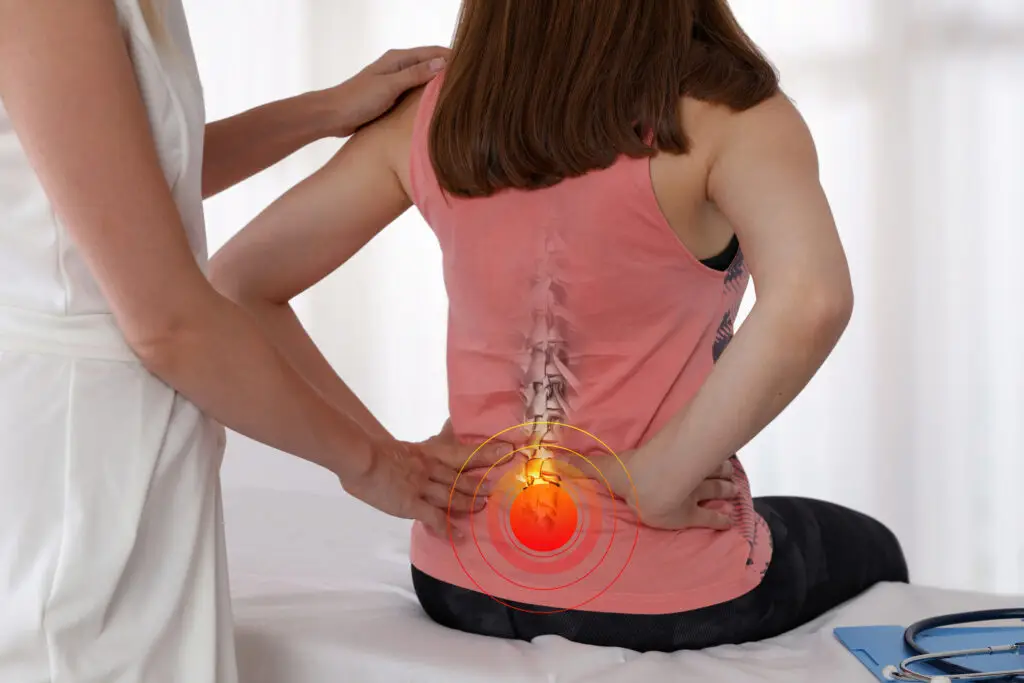It’s estimated that as many as 75% of us will have some form of back or neck pain at some point in our lifetime. The good news is that most of us will recover without the need for surgery—and conservative care such as physical therapy usually gets better results than surgery. Degenerative disk disease (DDD) is one cause of back and neck pain. Usually, the result of the natural aging process, degenerative disk disease (DDD) is a type of osteoarthritis of the spine.
What is Degenerative Disk Disease?
Your spine is made up of 33 vertebrae that are stacked on top of one another. Between each of these vertebrae is a rubbery piece of cartilage called an “intervertebral disk.” (See images below) Imagine the disk as a tire, with gelatin filling the hole in the tire. The tire is called the “annulus,” and the gelatin is called the “nucleus.” When we’re young, and under 30 years of age; the disk is made mostly of gelatin. As we age, and sometimes with injury or excessive wear and tear, we start to lose some of that gelatin, causing the volume of the disk to decrease. This decrease in volume will result in less space between the vertebrae. Once that occurs, the disk becomes flat and less flexible, leaving less space between each set of vertebrae. Sometimes bone spurs form in response to this degeneration of the disk, making the spine stiff. When the rough surfaces of the vertebral joints rub together, pain and inflammation may result. Nerves may become irritated or compressed.
Disk degeneration might occur throughout several regions of the spine, or it might be limited to one disk. When it’s part of the natural aging process, the degeneration does not always lead to pain. For some people, however, it can cause a great deal of pain and disability.
You are more likely to develop DDD if you:
- Smoke.
- Are obese.
- Do heavy physical work.
- Don’t get very much exercise.
How Does DDD Feel?
With Degenerative Disk Disease, you might have mild to intense neck and back pain…or no pain at all.
- A degenerative disk in the neck can cause pain in the arm, shoulder, or neck.
- A degenerative disk in the low back might cause pain in the back, buttocks, or legs.
The pain is often made worse by sitting, bending, and reaching. It may be worse first thing in the morning and after staying in any one position for a long time. In severe cases, when DDD results in pressure on the nerves, it can lead to numbness, tingling, and even weakness in the arms or legs.
How Can SportsCare Physical Therapists Help?
our physical therapist will conduct a thorough evaluation that includes a review of your medical history and will use screening tools to determine the likelihood of DDD. For example, the therapist may:
- Ask you very specific questions about the location and behavior of your pain, weakness, and other symptoms.
- Ask you to fill out a body diagram to indicate specific areas of pain, numbness, and tingling.
- Perform tests of muscle strength and sensation to determine the severity of the pressure on your nerves.
- Examine your posture and observe how you walk and perform other activities.
- Measure the range of motion of your spine and your arms and legs.
- Use manual therapy to evaluate the mobility of the joints and muscles in your spine.
- Test the strength of important muscle groups.
If you have muscle weakness and loss of sensation or very severe pain, special diagnostic tests, such as x-rays, may be needed. Physical therapists work closely with physicians and other healthcare providers to make certain that an accurate diagnosis is made and the appropriate treatment is provided. Your SportsCare Physical Therapists’ overall purpose is to help you continue to participate in your daily activities and life roles. The Therapist will design a treatment program based on both the findings of the evaluation and your personal goals. The treatment program likely will be a combination of exercises to help eliminate pain and increase movement.
Your therapist will design:
- Stretching and flexibility exercises to improve mobility in the joints and muscles of your spine and your extremities—improving motion in a joint is often the key to pain relief
- Strengthening exercises—strong trunk muscles provide support for your spinal joints, and strong arm and leg muscles help take some of the workload off your spinal joints
- Aerobic exercise, which has been shown to be helpful in relieving pain, promoting a healthy body weight, and improving overall strength and mobility—all important factors in managing DDD
Your physical therapist also might decide to use a combination of treatments:
- Manual therapy to improve the mobility of stiff joints and tight muscles that may be contributing to your symptoms
- Posture and movement education to show you how to make small changes in how you sit, stand, bend, and lift—even in how you sleep—to help relieve your pain and help you manage your condition on your own
- Special pain treatments—such as ice, electrical stimulation, or a short course of traction—for pain that is severe and not relieved by exercise or manual therapy
Once your pain is gone, it will be important for you to continue your new posture and movement habits to keep your back healthy.
Where Can I Be Treated?
SportsCare has over 70 locations from NJ, NY, and FL. We have world class Physical Therapists with plenty of experience to get you back to being the best you can be, and feeling the best you can. To find the nearest SportsCare Physical Therapy facility, you can:
- Text your zip code to 1-844-700-0013
- Go to our Website and search our locations based on your needs.


